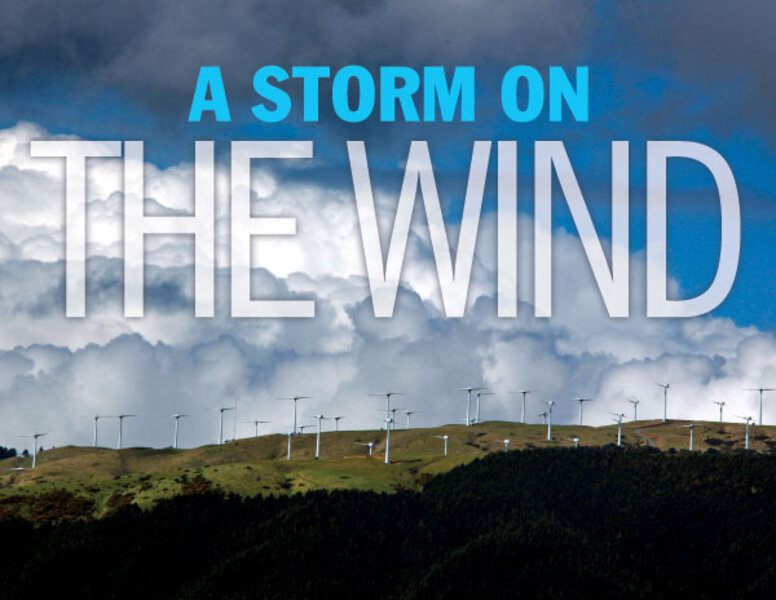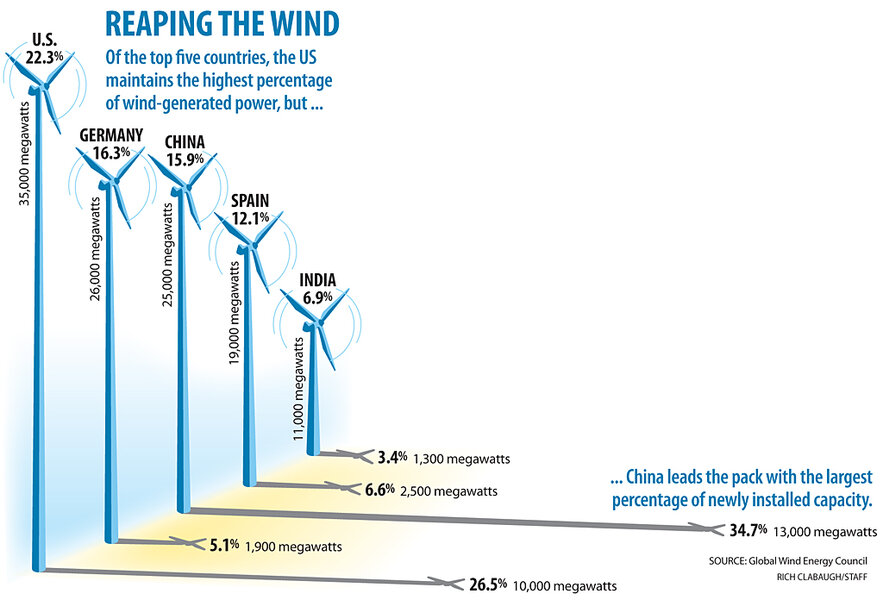Wind power: Clean energy, dirty business?
Loading...
| Mexico City
Like the oil drilling rig that became an icon of the Industrial Age, the giant, spinning wind turbine has become a global image of clean power.
No longer a futuristic dream of environmentalists, wind power has become a big business: Since the signing of the Kyoto Protocol on climate change in 1998, wind-generated electricity has grown 20-fold: from only enough to power the equivalent of two New York Cities, to 200,000 megawatts today – enough to power six Britains. (In an address Thursday about "American energy," linking clean energy to economic and national security, President Obama said that his administration would allow the development of green energy such as wind and solar on enough public lands to power 3 million homes.)
Wind's biggest impact may be in the developing world – indeed, according to the Global Wind Energy Consortium, 2011 was the first year the developing world installed more wind power facilities than the developed world. India is now fifth in wind power production. China, the global wind leader, installed more wind power in 2009 than existed on the planet prior to 2003. Morocco recently finished its first wind farm (200 megawatts) and, with plans to grow its capacity 10-fold by 2020, expects to export electricity to Europe.
For all the hope that wind energy offers a world eager to move away from costlier, more environmentally disruptive forms of electric power production, the industry is barreling into some of the same controversies and conflicts that its predecessors in natural resource exploitation faced, particularly in the developing world.
On one hand, says Paul Veers, chief engineer at the National Renewable Energy Laboratory: "The wind business is doing something no new electricity source has done in almost half a century – it's beginning to make an impact."
On the other hand, says Dan Kammen, a University of California, Berkeley, renewable energy scholar working on leave at the World Bank: "The conflicts that come up [with wind] are exactly the same ones that come up in basically every other land-based activity. We have done this in the past over Manifest Destiny and national security. The issue of the moment happens to be green energy, but there has been a history of this."
Towering turbines, often with blades as long as 30 yards, are installed in huge groups – wind farms – and require large tracts of land. Acquisition of that land has been a sometimes violent flash point in the new "wind rush," as explained in detail in the accompanying Monitor case study of Mexico's wind-rich Isthmus of Tehuantapec.
While energy and environmental experts note that the conflicts are still relatively few, they are cautionary lessons for the industry.
Wind takes off
"Much of Africa, Asia Pacific, and Latin America – as far as we see it – is on the verge of taking off," says Shruti Shukla, policy director of the Global Wind Energy Council.
The growth of wind power is driven partly by demand: China's electric power demand has doubled in just a decade, and India's peak demand is 12 percent higher than its available supply.
But also, national and international subsidies and incentives – such as carbon offsets that allow companies to invest in clean energy to "offset" carbon emissions in their dirtier businesses – have driven wind industry growth. Critics of the incentives say that every new turbine represents a blank check to pollute elsewhere. Supporters say it's a market-based solution meant to ease business into clean energy.
For Kyoto signatory nations it has meant a global rush to acquire land for wind turbines. Wind projects have been successful – notably, in Tamil Nadu, India, which experts like Ms. Shukla and Mr. Kammen cite as a model of responsiveness to local need and manageable scale.
Indeed, wind energy projects do generally inject economic benefits wherever they're built, but the development process often sparks anger, especially among poor landowners.
"What we see in many places, if not most places around the world, is very much what I would describe as the colonial model, where Europeans would go to Africa and other places and they say 'OK, we are going to develop this,' " says James Anaya, United Nations Special Rapporteur on the Rights of Indigenous Peoples. "And the deal that is being offered, in the end, is not a good one."
In 2001, Mr. Anaya won a landmark case in the Inter-American Court of Human Rights that involved logging rights in Nicaragua and established that indigenous people have exclusive right to their lands. He says that too often a government or business acquires land through unequal negotiations, in which indigenous people aren't given all the information or options.
Negotiating any wind contract is complex. Often in the developing world, communities are poorly educated or largely illiterate and don't understand the implications of a contract. They may simply have no access to legal and technical advice and they may be powerless to negotiate. And because parcels are small, they can be destroyed by turbine construction.
Kammen, a strong supporter of wind power, says that by comparison, biofuels have a far worse record than wind development for land grabs. Rampant abuses in Tanzania, he says, recently led to a ban there on all new biofuel investment. He says that most conflicts involving wind energy deal with land occupied – but not owned – by indigenous groups, such as in the Kutch District of India, where a case pitting local herders against Indian wind giant Suzlon Energy Ltd. went to the high court there. He worries about such conflicts arising with Morocco's nomadic herders.
Monitor reports abuse in India
In 2010, the Monitor documented a case in Dhule, India, where 2,000 adivasi – or tribesmen – were forced to accept hundreds of wind turbines on their traditional lands. They'd lived on the land for generations but had dubious title. The government gave the land to Suzlon, which, in some cases, bought out owners.
However, ownership doesn't guarantee fair treatment. In Honduras a wind energy company recently forced indigenous Lenca people who did have land title to take on a wind farm, paying each farmer as little as $80 per year to lease the land. In many cases, the owners were barred from their land.
Cases like this, in which landowners are either coerced into a contract or don't understand what they are signing, are beginning to worry indigenous rights activists.
"You are talking about land that is the basis for the existence and survival of cultures – of entire social-culture dynamics that define a people," says Anaya. "You are talking about the cultural survival of these people."
Elsewhere, it's not clear what effect the wind boom is having on civil rights. China has doubled production capacity in each of the past five years. It has a history of driving people from land for hydropower, but wind experts say China's grip on information makes it hard to know if the same goes for wind projects.
Asked about the conflicts cited here, Shukla says her industry organization is unaware of any wind development projects that have caused poor landowners any strife.
As the wind boom continues, indigenous ownership is a key issue.
Taking wind into their own hands
In the Great Plains of the United States, many native American communities have joined a movement to direct all development on their lands.
"The tribes were no longer satisfied with business as usual ... other people coming in, building some economic development project, owning it, taking the profits out, and leaving the tribe with it at the end of its life," says Robert Gough, a consultant with the Intertribal Council on Utility Policy, which represents 10 Great Plains tribes.
Many tribal communities there say they pay high electricity costs or have no electricity at all. So the council decided no wind farms will be built on tribal land unless the tribe has controlling interest.
Mr. Gough says the tribes have struggled to find partners because of these demands and because federal investment incentives are designed for businesses, not municipalities or reservations.
But communal bargaining is catching on. In southern Wyoming, 2,000 owners have pooled 2 million acres in "wind associations."
Many countries are trying to start domestic wind industries. For example, 15 years ago, foreigners built China's turbines; now Chinese corporations do it.
"At the end of the day, developing countries are energy deficient. And they do need power," says Shukla. "You want to be able to give them energy that is cleaner than what we have been providing across the world."








